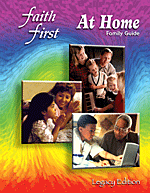Articles:
Faith First® At Home Family Guide
How Does Faith Begin in Families First?
Ten Tips to Help You Get Started

Faith First®
At Home Family Guide
Now families can do faith formation with ALL of their children at ONE time!
The Faith First At Home Family Guide is a visionary, yet practical approach to family learning and faith sharing. Now you can respect the schedule demands on today's families as parents gather with ALL of their children at the same time and still provide age-appropriate catechesis.
The Faith First At Home Family Guide provides 27 interactive sessions designed to be used at home with the children's Faith First student books. The unique session design allows children of various ages to learn on their own levels, yet discuss, pray, and complete activities together with the whole family.
- Easy-to-use chapters help families develop faith with children of various ages
- FREE online resources available for every family member at www.FaithFirst.com
- Affordable and flexible tool for family catechesis, religious education family clusters, neighborhood groups, and home schooling
Easy-to-understand overview of each lesson theme.
Lessons correlate to Faith First student book chapters. Complete lesson plans include every grade level at ONE time!
How Does Faith Begin in Families First?
Long before your children were old enough for school or any formal religion program, they were already beginning to grow in faith. They had already been living and growing in the midst of a community of faith —their family.
What does it say to your children that one of the most important occasions of their lives was the day of their Baptism? Even though they have no conscious recollection of that day, they have seen photographs, they have heard stories, and they know their godparents. When these family stories are told and retold, your children recognize the importance of those events, and they begin to gather impressions about faith and about religion.
What does it say to children that your family prays at mealtime? At bedtime? While you may not think of this as “teaching,” your children are learning much about faith lived in the care of God who loves them and hears their prayers. And when a loved one is ill and your family prays for recovery, your children learn that God is with us even in the most sad and frightening moments of life.
From the earliest experiences children come to know God through creation. Gradually, even the youngest child is introduced to the stories of Jesus. This is the beginning of readiness to hear and embrace the Gospel.
As your children attended Mass throughout early childhood, they came to know that there was something special about the place where they gathered with you and other members of the parish. Even as little children they recognized that special actions and events happened there. Soon they wanted to participate in Holy Communion.
Faith-filled moments permeate all of family life. It is true: faith happens in families first. And you as parents are blessed with love and grace to foster your children’s spiritual growth. Indeed, as parents you are uniquely able to teach your children –first because you yourselves are persons of faith and second because you are parents.
Ten Tips to Help You Get Started
1. Set a schedule when you will to work on the program. You might like to invite your children to share their opinions and set up a schedule together. If possible, choose a day of the week and time when you can meet consistently. A regular schedule will be easier to follow.
2. Choose a place to meet. Again, ask your children for their input. Do they prefer to work at a table or would they prefer to sprawl on the floor? However, keep in mind that televisions and telephones can be tempting distractions.
3. With your children, choose some items that you can use for your prayer environment. You might like to use a cloth that changes with the liturgical seasons or the seasons of the calendar year. You will also need a Bible and a candle for prayer. Use a candle that can be passed safely from one family member to another.
4. Choose a place for your family to pray. After completing the work, it is a good idea to change places or postures for prayer. This will help you and your children transition into a prayerful mood. For example, you might work at the kitchen table and then move to the living room for prayer. Or you could sprawl on the floor to work and then sit cross-legged on the floor to work.
5. You will need a Bible as you use Faith First® At Home. We recommend the New American Bible, or the New Revised Standard Version, Catholic Edition.
6. When asking your children for their ideas and responses in each session, remember that there is rarely only one way to express the correct answer. Always make certain that you affirm all the appropriate responses your children offer.
7. Young children will need some assistance when reading and working in their textbooks. You may need to work with them or you could ask an older sibling to help. Take turns reading aloud with young children and offer encouragement as they complete the activities.
8. Do everything possible to eliminate or limit distractions and interruptions. As a family, name and discuss possible interruptions and agree upon how you can avoid them. For example, you may agree not to take phone calls while you are working together.
9. Remember that working with your own children on the Faith First® At Home program is truly a privilege. By learning together as a family, your family will grow in faith together. Your family’s spirituality will be greatly enhanced. You will have opportunities to share important stories together and pray together on a regular basis.
10. In order for your family to experience success with Faith First® At Home this year, everyone must be committed to one another as well as to the program. Discuss this commitment together.
Checklist
• Decide when to meet.
• Choose a place to meet.
• Locate items you need for prayer.
• Choose a place to pray.
• Make sure you have a Bible.
• Determine how you will eliminate or limit distractions and interruptions.
• Make a commitment to one another and to the Faith First® At Home program.

